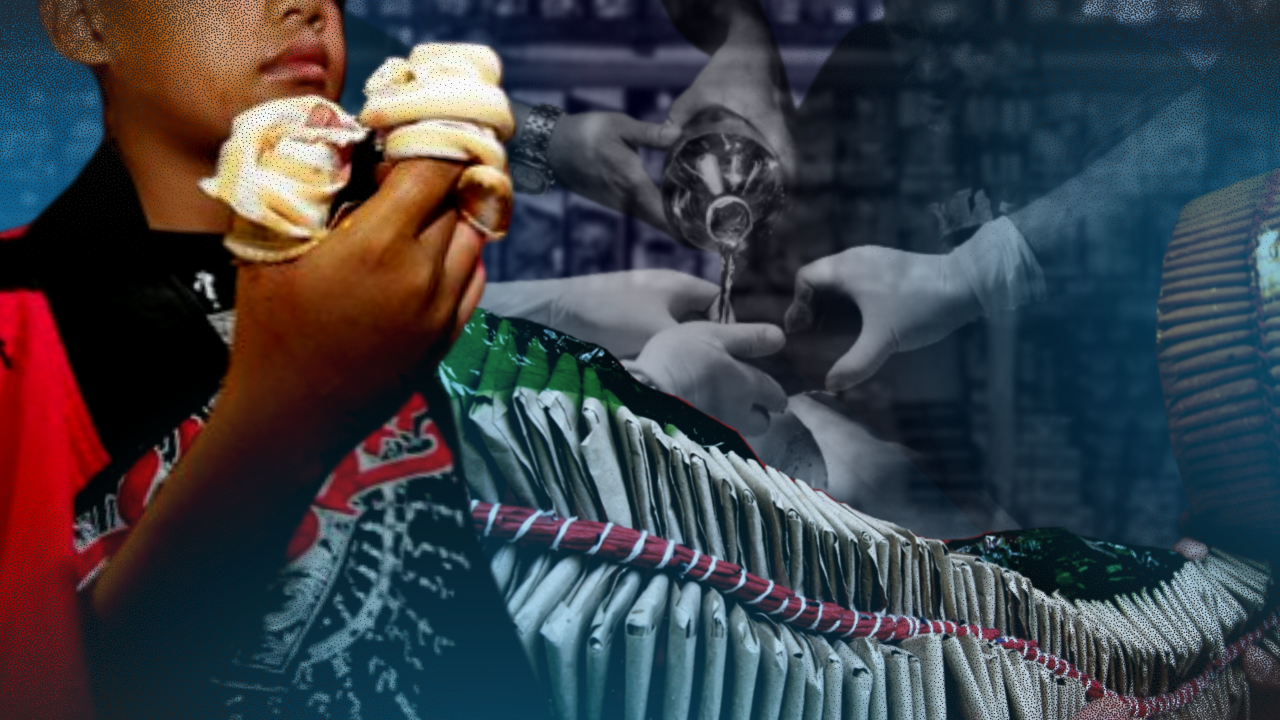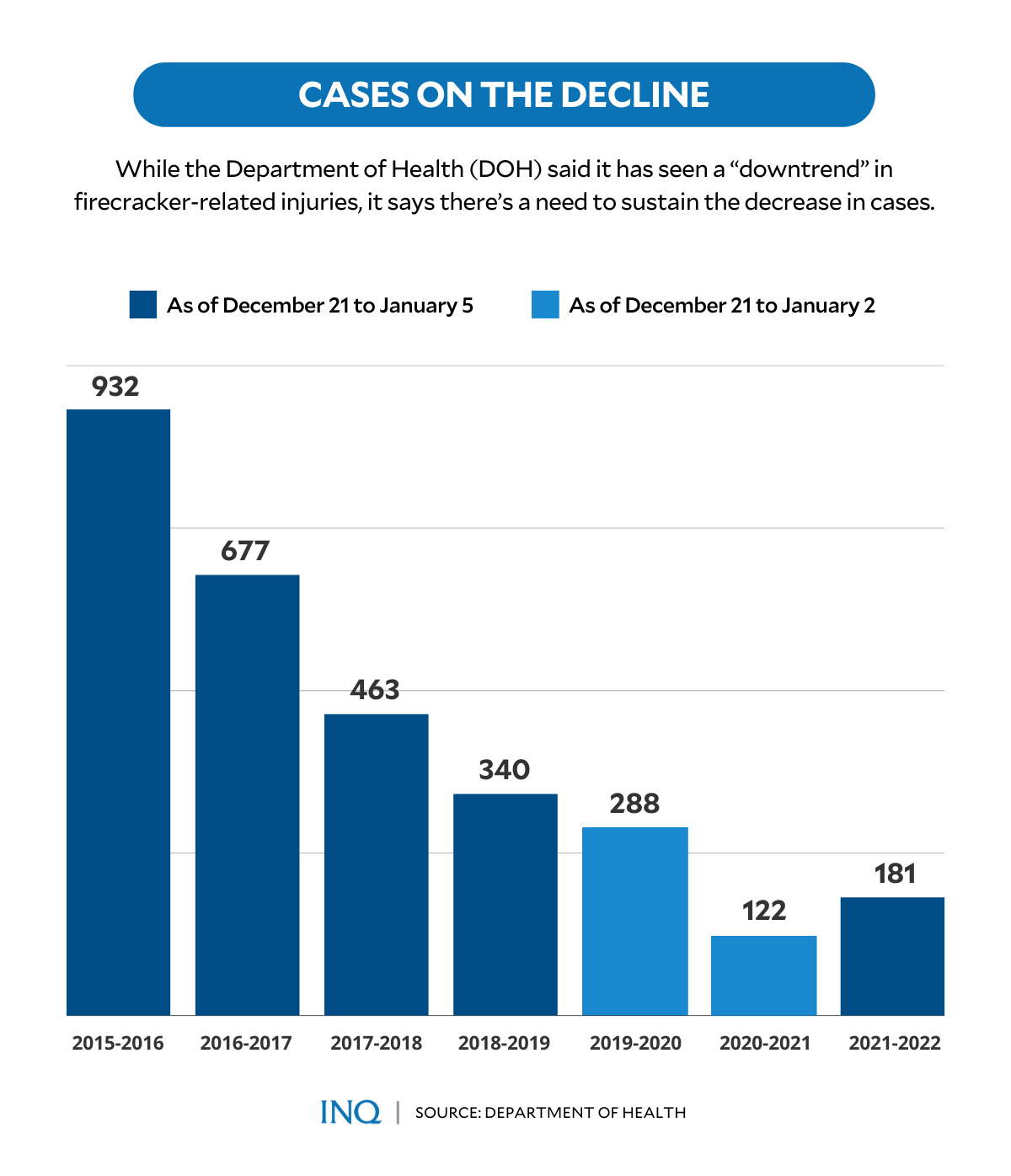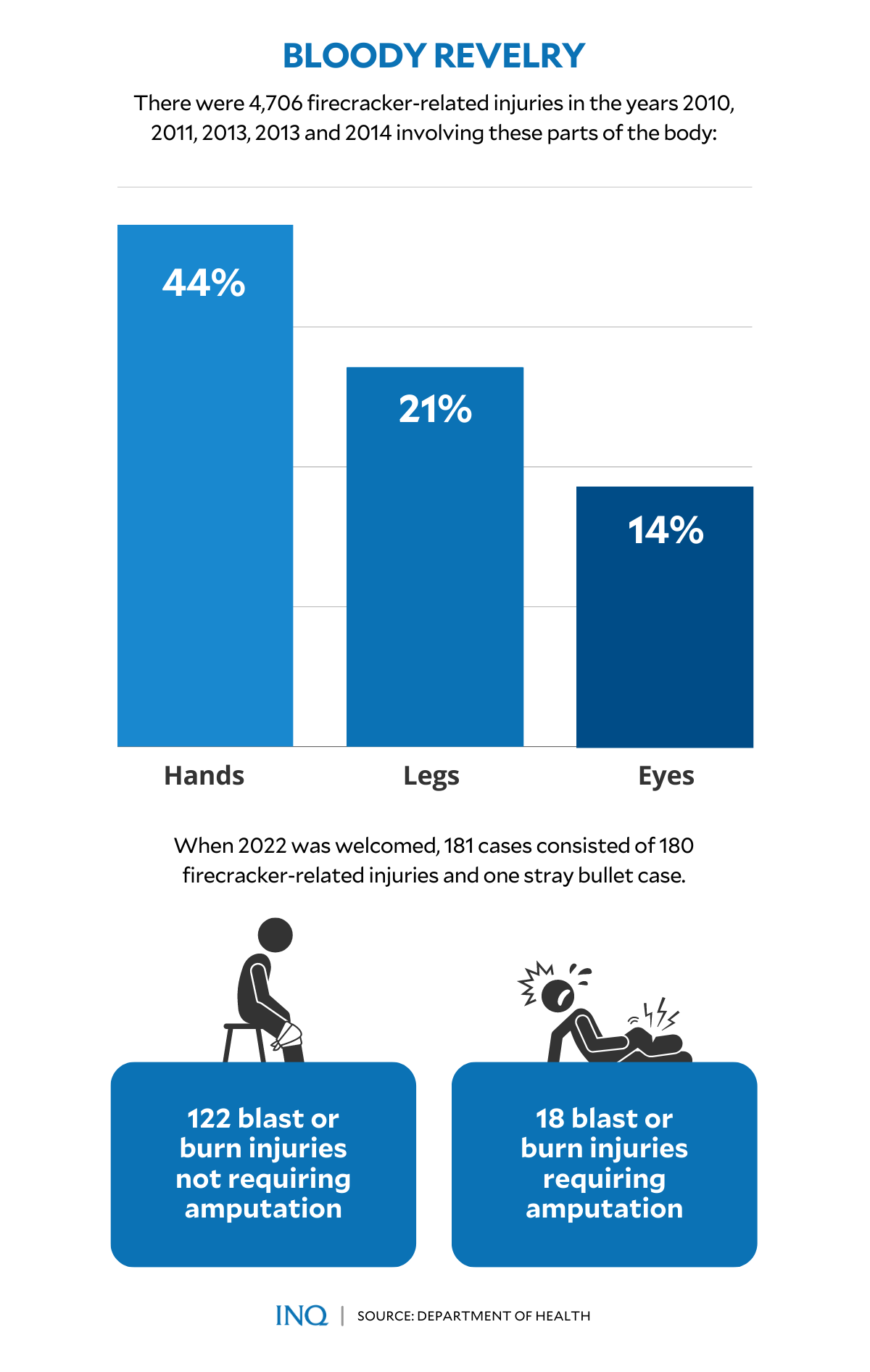Saying goodbye to 2022: Calls grow louder to keep firecracker harm at bay
MANILA, Philippines—Now that Christmas is over, Filipinos, certainly, are already preparing for the next celebration—New Year—which is highly characterized by the revelry that comes with it.
But should Filipinos still use firecrackers?
READ: A dangerous celebration
As stated in a 24 Oras report last year, historians explained that firecrackers were invented in 200 BC by the Chinese, who set bamboo on fire as they believed that it would ward off misfortune and evil spirits.
However, because of its dangerous, sometimes deadly, consequences, the government, through the years, has been discouraging Filipinos from using firecrackers, especially on the days leading to New Year’s Eve.
Article continues after this advertisementAs everyone knows, December of every year has been declared Firecrackers Injury Prevention Month as part of a concerted effort by government offices and private institutions to reduce firecracker-related injuries.
Article continues after this advertisementREAD: Firecrackers Injury Prevention Month
Then on June 20, 2017, then president Rodrigo Duterte signed Executive Order (EO) No. 28, a directive that restricted the use of firecrackers to community zones.
Looking back to 2019, then Health Secretary Francisco Duque III stressed that the EO contributed to the drop of firecracker-related injuries and that relentless rains experienced that year could also be credited for the decrease in cases.
This year, while the Department of Health (DOH) said it has seen a “downtrend” in firecracker-related injuries, it called everyone to help sustain the decline in cases.
According to DOH data over the years, there were 932 firecracker-related injuries on Dec. 21, 2015 to Jan. 5, 2016; 677 on Dec. 21, 2016 to Jan. 5, 2017; and 463 on Dec. 21, 2017 to Jan. 5, 2018.
RELATED STORY: Fireworks-related injuries rise to 10 in just 5 days
The number of cases continued to drop to 340 on Dec. 21, 2018 to Jan. 5, 2019; 288 on Dec. 21, 2019 to Jan. 2, 2020; and 122 on Dec. 21, 2020 to Jan. 2, 2021. Injuries, however, slightly increased to 181 on Dec. 21, 2021 to Jan. 2, 2022.
Creepy, deadly endings
According to data from the study Fireworks-related Injury Surveillance in the Philippines that was published by World Health Organization (WHO), there were 4,706 firecracker-related injuries involving different parts of the body in the years 2010, 2011, 2012, 2013, and 2014.
It said the most common anatomic injury areas were the hands (44 percent), legs (21 percent), and eyes (14 percent), stressing that males (80 percent) were more commonly injured than females.
When 2022 was welcomed, 181 cases consisted of 180 firecracker-related injuries while one was a stray bullet case. There were no cases of firecracker ingestion or death, the DOH said.
The victims, most of them males who were two to 74 years old, were from these regions: Metro Manila (67 percent), Ilocos Region (29 percent), and Western Visayas (26 percent).
A Philippine News Agency report said that out of the 180 firecracker-related injuries, 18 were blast or burn injuries requiring amputation and 122 were blast or burn injuries that did not require amputation.
Likewise, 45 of the 180 cases were eye injuries, while the rest—5—were multiple types of injuries.
The DOH said 47 percent of the cases involved active firecracker users, with some 52 percent getting injured at home, 47 percent on the streets, and one case on a basketball court.
Looking back, it was in 2015 when a drunken man died after he embraced a “Goodbye Philippines” firecracker that was about to explode. He was rushed to the hospital but was pronounced dead on arrival.
According to data from the study, written by Roca et. al., there were four firecracker-related deaths in the five years that it covered: 2010, 2011, 2012, 2013, and 2014.
Legal, illegal
As stated by Republic Act No. 7183, or the Act Regulating the Sale, Manufacture and Use of Firecrackers and Other Pyrotechnic Devices, the Philippine National Police (PNP) is authorized to determine what constitutes prohibited firecrackers.
Likewise, the PNP, through its director general, shall promulgate rules and regulations to regulate and control firecracker use after public hearing and consultation with the firecracker and pyrotechnic industry.
Last year, the PNP released the list of illegal firecrackers that can be seized by police, stressing that the sale of firecrackers outside firecracker zones comes with stiff penalties.
The illegal firecrackers, the police said, are Watusi, Piccolo, Pop-pop, Five-star, Pla-pla, Lolo Thunder, Giant Bawang, Giant Whistle Bomb, Atomic Bomb, Super Lolo, Atomic Triangle, Goodbye Bading, Large Size Judas Belt, Goodbye Philippines, Goodbye De Lima, Bin Laden, Hello Columbia, Goodbye Napoles, Mother Rockets, Coke-in-Can, Super Yolanda, Pillbox, Boga, Kwiton and Kabasi.
Roca et. al. said lighting illegal firecrackers accounted for 50.2 percent of injuries in 2010, 2011, 2012, 2013, and 2014. Likewise, most of the severe injuries were because of the explosion of illegal firecrackers.
The DOH had stressed that firecrackers, legal or illegal, are dangerous.
Duque stated in 2020 that the DOH would propose a law to impose an absolute ban on the use of firecrackers in the Philippines, stressing that most of the injuries during New Year that year, were attributed to legally sold fireworks.
“It’s a bit oxymoronic to say that it is legal but it is injurious. They are conflicting. So we need to do something about this,” he said.
READ: ‘Oxymoronic’: Most injuries due to legal fireworks–DOH
“In fact, it can contribute to higher injuries because of the understanding of the common person that since it’s legal, it wouldn’t cause problems,” Duque, who said the DOH was still far from achieving its goal of zero casualty, said.
Hidden dangers
But aside from injuries caused by firecrackers, the EcoWaste Coalition warned of the harmful chemicals that firecrackers and fireworks release into the air, saying that the products threaten health and the environment.
“These products are packed with chemicals such as carbon, potassium nitrate, sulfur and other substances of concern, which can adversely affect the rights of every Filipino to a clean and non-toxic environment,” it said.
Likewise, it stressed that the use of firecrackers worsen air quality, saying that in a study by the Manila Observatory in 2019, the amount of fine particulate matter in the air exceeded the 24-hour national ambient air quality guideline value (NAAQGV) of 50.0 µg/m3.
As pointed out by Aileen Lucero, national coordinator of EcoWaste Coalition, the group would want a comprehensive ban on firecrackers and fireworks to address toxic pollution caused by these.
“[This] infringes on our right to clean air – a human right recognized and protected by the Clean Air Act,” she said.
Local chief executives are mandated to assign specific firecracker and pyrotechnic zones in their areas, where firecrackers may be sold and used.
New cases
According to latest data from the DOH, there are 20 cases of firecracker-related injuries as 15 new cases were reported on Monday (Dec. 26), less than a week before the New Year celebration.
The injuries, the department said, were recorded in Central Visayas (3), Soccsksargen (3), Ilocos Region (2), Bicol Region (2), Western Visayas (2), Davao Region (2), Metro Manila (2), Central Luzon (1), Calabarzon (1), Mimaropa (1), and the Cordillera Administrative Region (1).
Some 30 percent of the injuries were caused by the firecracker called Boga, which has been declared by the police as illegal. The rest were caused by Kwitis, Whistle Bomb, 5-Star, Judas Belt, “Missile”, Pop-pop.
According to data submitted to DOH’s sentinel hospitals, most, or 11, of the cases were eye injuries, while two cases were blast or burn injuries requiring amputation.



